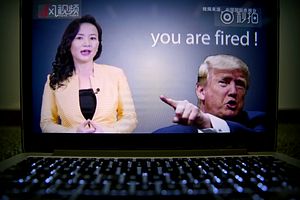On August 22 and 23 in Washington, DC, the United States and China held the latest round of talks seeking a possible end to their ongoing trade war. It was the first dialogue since the first round of U.S. tariffs on $34 billion worth of Chinese goods – and China’s reciprocal duties – went into effect on July 6. A second round of tariffs, on an additional $16 billion of Chinese products, went into effect on Thursday, as the talks were ongoing. Based on the underwhelming conclusion of this week’s talks, it’s only a matter of time before the next salvo is fired.
Ahead of the discussions, there was not much optimism from either side – particularly given the relatively low level of the negotiations. Wang Shouwen, vice minister of commerce and deputy international trade representative, led the Chinese delegation while David Malpass, undersecretary of international affairs at the Treasury Department, represented the United States. Even U.S. Commerce Secretary Wilbur Ross dismissed the discussions as “relatively low-level, relatively exploratory sessions.”
Both before and after the talks, there was little to suggest that either side had substantially changed its position. The United States has a litany of trade complaints against China, ranging from intellectual property theft to market access restrictions. But most notably, Washington wants Beijing to scale back its “Made in China 2025” strategy, which aims to make China a world leader in key technology fields like artificial intelligence and robotics. China, for its part, is prepared to address the U.S. trade deficit by upping imports from the United States and possibly lowering some market barriers, but is unwilling to change its core economic strategy.
Reports indicated there was little progress on bridging that gap this week. As Bloomberg reported:
According to the person familiar with the discussions, the U.S. Treasury presented a revised version of the provocative list of demands presented by the Trump administration when the two sides had their first high-level meetings in May. The Chinese delegation, meanwhile, showed no signs of bringing any significant compromises to the table this week.
In other words, the two sides remain just as far apart as they were before the tariffs hits. If anything, given the heated public rhetoric from both sides, finding a compromise has only become harder.
Official statements from the United States and China didn’t offer much cause for hope, either. Based on the U.S. readout, it seemed like the “talks” mostly consisted of American officials complaining about China’s trade policies. “We… exchanged views on how to achieve fairness, balance, and reciprocity in the economic relationship, including by addressing structural issues in China,” a White House spokesperson said.
China’s Ministry of Commerce, meanwhile, declared the talks to have been “constructive and candid” and added, “Both sides will keep in contact about the future arrangement.”
In another context, the act of talking itself could be seen as an achievement, given that negotiations had been on hiatus since June, following a short-lived “breakthrough” in May. But with no follow-on talks scheduled, this week’s dialogue looks more like a one-off than the resumption of a process of negotiation. Bloomberg reports that “Chinese officials had raised the possibility that no further negotiations could happen until after November’s mid-term elections in the U.S.”
That would be well after next round of tariffs is expected to take effect. The Trump administration has promised tariffs on another $200 billion in Chinese goods. The public comment period on that proposal ends September 6 and the tariffs could be unveiled immediately after that.
In fact, even while Wang and Malpass were meeting, the United States was holding hearings on that next round of tariffs.

































